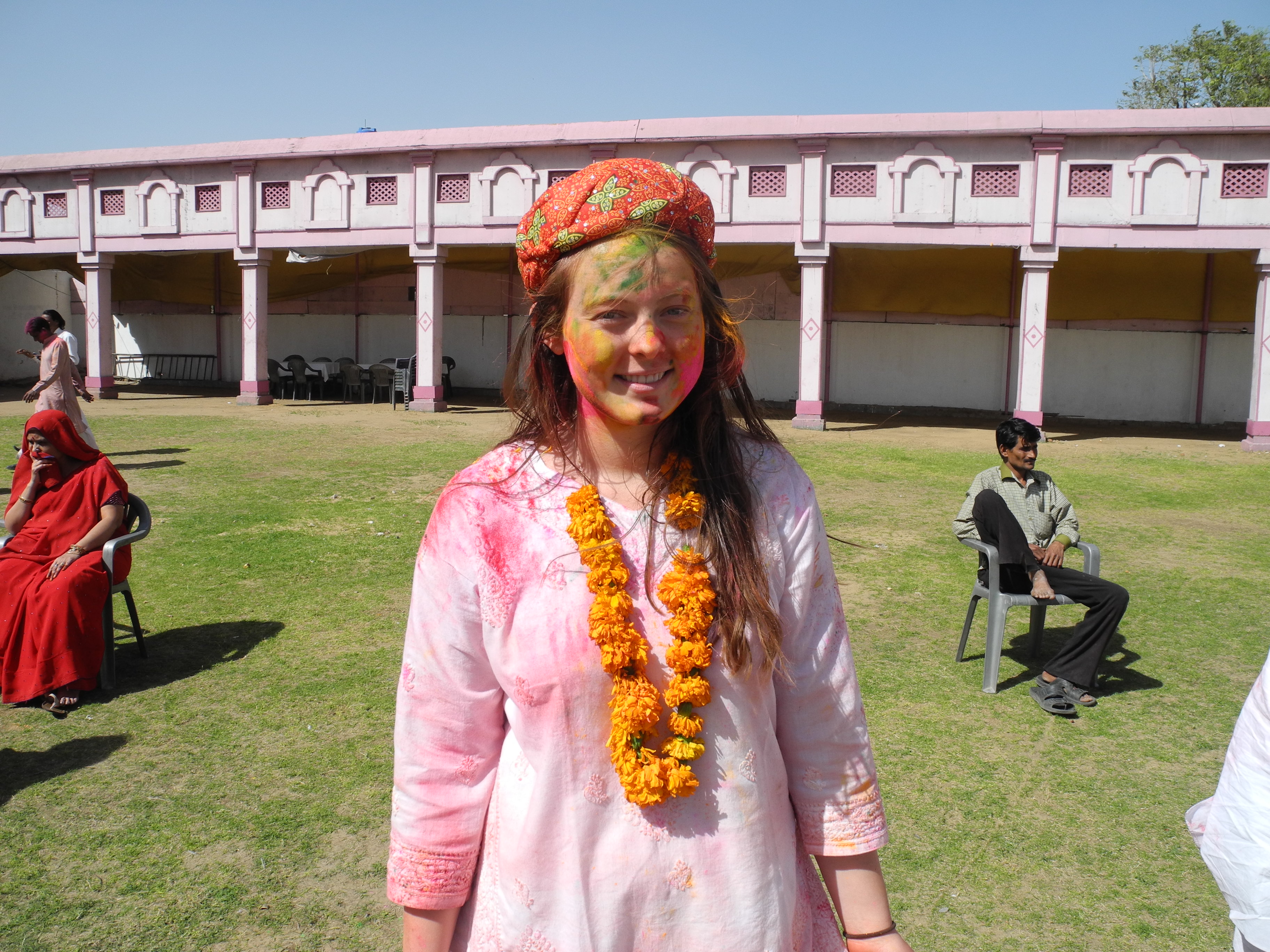Popular Volunteer Programs
- Teaching Volunteer Project
- Street Children Projects
- Orphanage Assistance
- Child Care volunteer Project

Popular Internships Programs
- Microfinance Internships
- Social Development Internship
- Public Health
- Medical Care & Treatment Internship

Culture & Facts

Crowned by the world's highest mountain range "The Himalayas"and surrounded by Pakistan, Nepal, China, Bhutan and Bangladesh, stands India. It is the largest sovereign, democratic, republic in South Asia. India's coastline stretches over a distance of seven thousand kilometers. It is surrounded by the Arabian Sea in the west, the Bay of Bengal in the east and the Indian Ocean in the South. Comprising twenty-eight states, seven Union Territories and one National Capital Territory, Delhi, India is the seventh-largest country of the world. With a population of 1,210,193,422, India is the second-most populated country in the world.
India has a glorious history, which dates back to 3200 B.C. Beginning with the Indus Valley Civilization in India when Hinduism took birth, India has had a rich historical lineage. India was the richest nation of the world and was known as "The Golden Bird". The rich natural resources, the rich culture and wealth of India attracted many foreign invaders. Some came for business or studies and some to plunder. It is also during this period that different foreign cultures and religions were introduced in India. Similarly, some religions like Buddhism and Jainism, which took birth in India spread all over the world.
The diverse religion, cultures, customs, languages and religions portray a colorful picture of India. As a result of this many tourists are attracted to visit India and experience its natural beauty and rich cultural heritage. Today, India is the one of the most famous tourist destinations of the world. It possesses immense natural beauty and the beautiful cities with historical monuments are representative of India 's rich architecture and craftsmanship.
India is listed amongst the developing countries of the world. In the past few years it has shown rapid growth in almost all its service sectors and industries earning the title "India Shining".
Geography
India can be divided into seven regions- Northern mountain ranges which includes the Himalayas and the North-eastern mountain ranges; Indo-Gangetic plain; deserts; Central highlands and Peninsular plateau; east coast; west coast; bordering seas and islands. The rivers can be divided into three groups: the great Himalayan rivers of the north, the westward-flowing rivers of central India, and the eastward-flowing rivers of the Deccan Plateau and the rest of peninsular India.
Climate
India is so vast, that the climatic conditions in the far north have nothing to do with those of the extreme south. To summarize, the country has three seasons: hot, wet and cool. In the northern plains, the heat begins to rise in February to become unbearable in April-May. In the center, temperatures of 45 ° C or more are common, the air is dry and dusty landscape embedded in a heat haze. The first signs of the monsoon appear towards the end of May: high humidity, short and heavy rain storm, storms. The monsoon sets in early June in the south and up north to cover the entire country in the first days of July, without bringing much freshness, it ends in October in most parts of the country. The main monsoon comes from the southwest. The southeast coast is affected by the northeast monsoon is short and surprisingly wet from mid-October to late December. After the monsoon, the north has cool or cold nights in December and January. It is never cold in the far south, which enjoys pleasant temperatures during the cool season, unlike the far north, which becomes downright cold.
extreme south. To summarize, the country has three seasons: hot, wet and cool. In the northern plains, the heat begins to rise in February to become unbearable in April-May. In the center, temperatures of 45 ° C or more are common, the air is dry and dusty landscape embedded in a heat haze. The first signs of the monsoon appear towards the end of May: high humidity, short and heavy rain storm, storms. The monsoon sets in early June in the south and up north to cover the entire country in the first days of July, without bringing much freshness, it ends in October in most parts of the country. The main monsoon comes from the southwest. The southeast coast is affected by the northeast monsoon is short and surprisingly wet from mid-October to late December. After the monsoon, the north has cool or cold nights in December and January. It is never cold in the far south, which enjoys pleasant temperatures during the cool season, unlike the far north, which becomes downright cold.
The best time to visit India is from mid-November to late March, except for the South East and the extreme south, because of the late monsoon. In May, temperatures range between 30 and 40 ° C.
Its great extent in latitude and the greater extremes at the relief (the warm seas of the Kerala ,high peaks of the Himalayas) allow India to have a variety of unique flora and fauna in the world, and offer so fascinating plurality of landscapes according to the climatic and agricultural seasons.
People
In a cosmopolitan sub-continent like India in its incredible form, tourists and travelers discover a rich amalgamation of versatile customs and traditions, values and culture broadly categorized as north India culture holidays, south India culture holidays, east India culture holidays, west India culture holidays on the basis of lifestyle that people distinctly represent from their own regions. These variations of lifestyle are found among the people of India mainly because of its geographical diversity conditioned the entire way of life. However, the travelers will find the changes in dialects, colors, clothing, food style, taste, habits, manners, behaviors, music and dance (specially of folk music) and many other living styles when they will pass by the inter-state boundaries while traveling by Indian railways or making car city tourism. So, the lifestyle of the people of India is very much conditioned by its geography representing Himalayan Regions from its northern side, Indian Ocean from its southern side, Arabian Ocean from its western side and Bay of Bengal from its eastern side.
It depends on the mood of travelers whether they are interested to take general overview of the lifestyle of the people of India or specific view of the people of India and their lifestyle. For general overview, travelers, while traveling to the famous travel destinations of India like south India, north India, east India and west India, they will automatically observe the variations of lifestyle while using things used in daily life but for the specific overview of the people of India, travelers have to interact with the local people professionally, keeping in mind the culture, traditions and values of the tourist destination.
Festivals
Due to regional differences, India has a variety of festivals and holidays. On 26 January,
Diwali, or Deepavali (October-November), the Festival of Lights, lasts for five days. It celebrates the return from exile of Rama and is dedicated to Lakshmi, Kali and Krishna. It marks the last Jain New Year.
Dussehra celebrates the victory of the Hindu god Rama over the demon king Ravana and the triumph of good over evil. It is especially festive in Mysore. The Muslim festival of Muharram (first month of the Muslim year), which lasts ten days, is very important in Lucknow. In a grand procession of penitents hit with a whip and commemorating the martyrdom of Hussain.
Republic Day (January 26), Independence Day (15 August), Gandhi Jayanti (October 2), plus the religious festivals and holidays of each State
Language
Despite its official status, Hindi is spoken by 20% of the population. It is therefore understood better vehicular role played by English. The Constitution recognizes 22 official languages, which are divided into two major groups - Indo-Aryan and Dravidian - and there are also 1,600 minor languages and dialects. Hindi predominates in the North and the South in Tamil, Assamese, Bengali, Gujurati, Kannada, Kashmiri, Malayalam, Marathi, Oriya, Punjabi, Sanskrit, Telugu and Urdu are also used.
Arts, Culture and Music of India
India boasts of a rich cultural heritage. The music and dance of the country is based on the Natya Shastra, a form of Sanskrit music and dance that was practiced during the 2nd century AD. The music can be divided into the North Indian Hindustani style and the South Indian Carnatic (Karnatak) style. Dance is also a major art form in India. The major classical dance forms include Bharata Natyam, Kathak, Manipuri, and Kathakali. As far as Indian art goes, its architecture, sculpture, and painting have developed many distinct styles over the centuries and is widely accepted all over the world. Most of the designs have religious touches to it.
FOOD
It is loud and says: Discovery of India also passes through the exploration of its cuisine. According to religion, caste, region where he lives, the Indian does not eat the same as its neighbor.
Banquet of aromas, flavors, textures and colors, Indian cuisine expresses metaphorically the personality of the country. It defies simplistic classification, as there is great diversity among regions. The culinary differences between North and South are in particular due to climate and historical influences.
the personality of the country. It defies simplistic classification, as there is great diversity among regions. The culinary differences between North and South are in particular due to climate and historical influences.
Strict vegetarianism is bordered to the south, the state of Gujarat and some holy cities. The cow is sacred, but Muslims restaurants serve buffalo. In the North, meat, bread and cereals are more common, as the mughlaie kitchen, akin to those of the Middle East and Central Asia, where spices play a more important role than the chili.
In the south, rice and vegetarian dishes accompanied, for the most strongly (or extremely)statements. Dhal - kind of lentil stew - is omnipresent, accompaniment or basic meals. The thali, a native of South India, is eaten throughout the country. This assortment of dishes, served in the South on a covered tray with fresh banana leaves, form a complete meal. You will enjoy curries of meat or fish and succulent tandoori (weaker than the curries). In the South, the masala dosa, a pancake flour stuffed lenses vegetables, is a excellent snack - or a meal! Lassi, beat sweet or salty yogurt, calm fire food.
Spices are a vital part of food preparation and are used to enhance the flavor of a dish. Correct use and blending of the aromatic spices is crucial to the proper preparation of Indian cuisine. Even oil is an important part of cooking, whether it's mustard oil in the north or coconut oil in the south, each section of the country has it's preferences.












